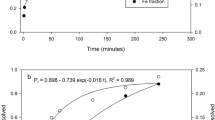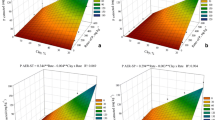Abstract
The reaction between soil and phosphate was studied using a method in which a sample of the soil solution was displaced by centrifuging moist soil with a dense, immiscible organic liquid. The soil solution floats on the organic liquid and can be removed for analysis.
Phosphate concentrations in the soil solution so displaced were lower than those estimated by the null-point method using 0.01M calcium chloride. The differences were shown to be closely associated with the lower calcium concentration of the soil solution.
Adsorption from solutions of monovalent phosphate salts was accompanied by accumulation of cations in the soil solution. It was argued that this occurred because the average charge conveyed to the adsorbing surfaces was less than unity. Calculated values were between 0.90 and 0.96. The remainder of the charge was balanced by release of hydroxide ions and small increases in pH were observed.
The immiscible displacement method appeared to be potentially valuable for many studies of the reaction between chemicals and soil. Its main disadvantage is that the volume of solution available for analysis is small and this places limits on the sensitivity.
Similar content being viewed by others
References
Barrow NJ (1982) A discussion of the methods for measuring the rate of reaction between soil and phosphate. Fertilizer Res (in press)
Barrow NJ and Shaw TC (1975) The slow reactions between soil and anions. 2. Effect of time and temperature on the decrease in phosphate concentration in the soil solution. Soil Sci 119:167–177
Barrow NJ, Malajczuk N and Shaw TC (1977) A direct test of the ability of vesicular-arbuscular mycorrhiza to help plants take up fixed soil phosphate. New Phytol 78:269–276
Barrow NJ, Bowden JW, Posner AM and Quirk JP (1980) Describing the effects of electrolyte on adsorption of phosphate by a variable charge surface. Aust J Soil Res 18:395–404
Bowden JW, Nagarajah S, Barrow NJ, Posner AM and Quirk JP (1980) Describing the adsorption of phosphate, citrate and selenite on a variable-charge mineral surface. Aust J Soil Res 18:49–60
Bowden JW, Posner AM and Quirk JP (1980) Adsorption and charging phenomena in variable charge soils. In Theng BKG, ed. Soils with variable charge, pp 147–166. Lower Hutt, New Zealand: New Zealand Society of Soil Science
Gillman GP (1979) A proposed method for the measurement of exchange properties of highly weathered soils. Aust J Soil Res 17:129–139
Mubarak A and Olsen RA (1976) Immiscible displacement of the soil solution by centrifugation. Soil Sci Soc Am J 40, 329–331
Murphy J and Riley JP (1962) A modified single solution method for the determination of phosphate in natural waters. Anal Chem Acta 27:31–36
Pritchard DT (1967) Spectrophotometric determination of aluminium in soil extracts with xylenol orange. Analyst 92:103–106
Whelan BR and Barrow NJ (1980) A study of a method for displacing soil solution by centrifuging with an immiscible liquid. J Envir Qual 9:315–319
Author information
Authors and Affiliations
Rights and permissions
About this article
Cite this article
Barrow, N. An evaluation of the immiscible displacement method for studying the reaction between soil and phosphate. Fertilizer Research 3, 423–433 (1982). https://doi.org/10.1007/BF01048945
Issue Date:
DOI: https://doi.org/10.1007/BF01048945




